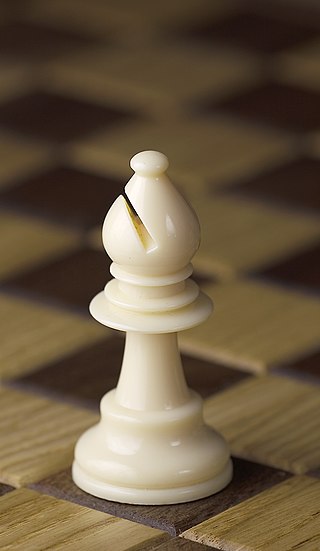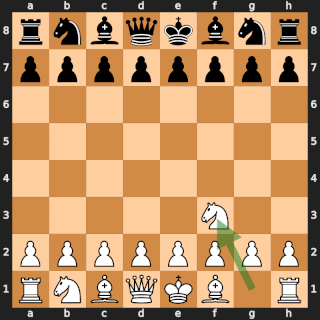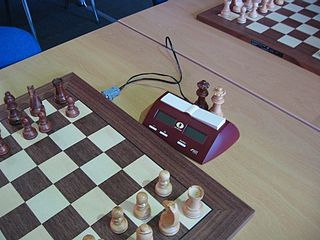
The queen is the most powerful piece in the game of chess. It can move any number of squares vertically, horizontally or diagonally, combining the powers of the rook and bishop. Each player starts the game with one queen, placed in the middle of the first rank next to the king. Because the queen is the strongest piece, a pawn is promoted to a queen in the vast majority of cases.

The bishop is a piece in the game of chess. It moves and captures along diagonals without jumping over intervening pieces. Each player begins the game with two bishops. The starting squares are c1 and f1 for White's bishops, and c8 and f8 for Black's bishops.
In chess, a pin is a tactic in which a defending piece cannot move out of an attacking piece's line of attack without exposing a more valuable defending piece. Moving the attacking piece to effect the pin is called pinning; the defending piece restricted by the pin is described as pinned. Only a piece that can move any number of squares along a horizontal, vertical, or diagonal line can pin. Any piece can be pinned except the king. The pin is one of the most powerful chess tactics.
This glossary of chess explains commonly used terms in chess, in alphabetical order. Some of these terms have their own pages, like fork and pin. For a list of unorthodox chess pieces, see Fairy chess piece; for a list of terms specific to chess problems, see Glossary of chess problems; for a list of named opening lines, see List of chess openings; for a list of chess-related games, see List of chess variants; for a list of terms general to board games, see Glossary of board games.

The Game of the Century is a chess game that was won by the 13-year-old future world champion Bobby Fischer against Donald Byrne in the Rosenwald Memorial Tournament at the Marshall Chess Club in New York City on October 17, 1956. In Chess Review, Hans Kmoch dubbed it "The Game of the Century" and wrote: "The following game, a stunning masterpiece of combination play performed by a boy of 13 against a formidable opponent, matches the finest on record in the history of chess prodigies."

In chess, a smothered mate is a checkmate delivered by a knight in which the mated king is unable to move because it is completely surrounded by its own pieces.
The Giuoco Piano is a chess opening beginning with the moves:
The Two Knights Defense is a chess opening that begins with the moves:
The zwischenzug is a chess tactic in which a player, instead of playing the expected move, first interposes another move posing an immediate threat that the opponent must answer, and only then plays the expected move. It is a move that has a high degree of "initiative". Ideally, the zwischenzug changes the situation to the player's advantage, such as by gaining material or avoiding what would otherwise be a strong continuation for the opponent.
In chess, a tactic is a sequence of moves that each makes one or more immediate threats – a check, a material threat, a checkmating sequence threat, or the threat of another tactic – that culminates in the opponent's being unable to respond to all of the threats without making some kind of concession. Most often, the immediate benefit takes the form of a material advantage or mating attack; however, some tactics are used for defensive purposes and can salvage material that would otherwise be lost, or to induce stalemate in an otherwise lost position.
The Vienna Game is an opening in chess that begins with the moves:
In chess and similar games, check is a condition that occurs when a player's king is under threat of capture on the opponent's next turn. A king so threatened is said to be in check. A player must get out of check if possible by moving the king to an unattacked square, interposing a piece between the threatening piece and the king, or capturing the threatening piece. If the player cannot remove the check by any of these options, the game ends in checkmate and the player loses. Players cannot make any move that puts their own king in check.
In chess and other related games, a double check is a check delivered by two pieces simultaneously. In chess notation, it is almost always represented the same way as a single check ("+"), but is sometimes symbolized by "++". This article uses "++" for double check and "#" for checkmate.

In chess, promotion is the replacement of a pawn with a new piece when the pawn is moved to its last rank. The player replaces the pawn immediately with a queen, rook, bishop, or knight of the same color. The new piece does not have to be a previously captured piece. Promotion is mandatory when moving to the last rank; the pawn cannot remain as a pawn.
The Légal Trap or Blackburne Trap is a chess opening trap, characterized by a queen sacrifice followed by checkmate with minor pieces if Black accepts the sacrifice. The trap is named after the French player Sire de Légall. Joseph Henry Blackburne, a British master and one of the world's top five players in the latter part of the 19th century, set the trap on many occasions.
In chess, a sacrifice is a move that gives up a piece with the objective of gaining tactical or positional compensation in other forms. A sacrifice could also be a deliberate exchange of a chess piece of higher value for an opponent's piece of lower value.
In chess, a desperado is a piece that is either en prise or trapped, but captures an enemy piece before it is itself captured in order to compensate the loss a little, or is used as a sacrifice that will result in stalemate if it is captured. The former case can arise in a situation where both sides have hanging pieces, in which case these pieces are used to win material prior to being captured. A desperado in the latter case is usually a rook or a queen; such a piece is sometimes also called crazy or mad.
In chess, the Muzio Gambit, sometimes called the Polerio Gambit, is an opening line in the King's Gambit in which White sacrifices a knight for a large lead in development and attacking chances. It begins with the moves:
A battery in chess is a formation that consists of two or more pieces on the same rank, file, or diagonal. It is a tactic involved in planning a series of captures to remove the protection of the opponent's king, or to simply gain in the exchanges.
In chess, a skewer is a tactic in which a long range attacker attacks two targets on the same rank, file or diagonal; and is similar to a pin. A skewer is often considered to be the opposite of a pin; the supposed difference is that in a skewer, the more valuable piece is the one under direct attack and the less valuable piece is behind it. The opponent is compelled to move the more valuable piece to avoid its capture, thereby exposing the less valuable piece which can then be captured. However, this is not quite a full and accurate understanding of a skewer, because two pieces of equal value can be subjected to a skewer. For example, two bishops standing on the same rank or file can be skewered by a rook; or two rooks on the same diagonal can be skewered by a bishop. Only line pieces can skewer; kings, knights, and pawns cannot.






